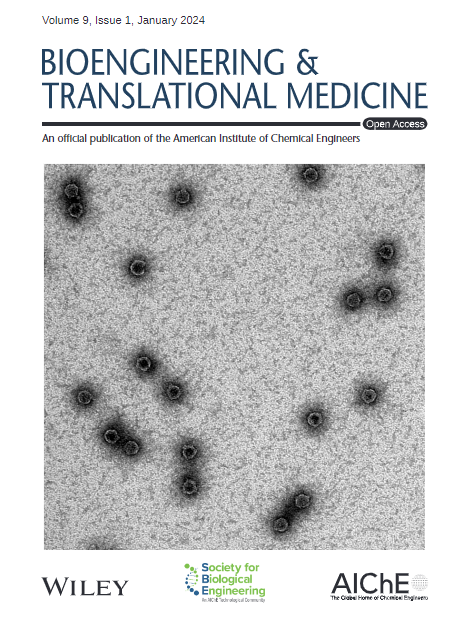Site‐specific noninvasive delivery of retrograde viral vectors to the brain
IF 5.7
2区 医学
Q1 ENGINEERING, BIOMEDICAL
引用次数: 0
Abstract
Neuronal activity underlies the brain function. Different behaviors, physiological processes, and disorders depend on which neurons are active at a given moment. Treating brain disorders without side effects will require exclusive control of disease‐relevant neurons. Traditionally, small molecule drugs could control a subset of neurons that express a molecularly specific receptor. Local noninvasive therapies such as delivery of neuromodulatory agents with focused ultrasound blood–brain barrier opening (FUS‐BBBO) also added spatial precision, allowing one to control specific brain regions without surgery. However, the final characteristic of neurons, which other neurons they connect to, remains underexplored as a therapeutic target. If targeting neurons based on their connectivity was possible noninvasively, it would open the doors to broadly deployable precise therapies that can target selected subgroups of neurons within a brain region. Such delivery could be achieved with retrograde‐tracing adeno‐associated viral vectors (AAVs). For noninvasive delivery with FUS‐BBBO, AAV9 has emerged as the most promising serotype. However, its retrograde‐tracing version, the AAV9.retro, has not been evaluated for FUS‐BBBO delivery. Here, we show that following such noninvasive delivery, AAV9.retro can safely transduce neuronal projections with comparable efficiency to a direct intracranial injection. Compared to AAV8, a naturally occurring vector with low retrograde transduction, AAV9.retro offers superior retrograde transduction and comparable transduction at the site of delivery. Overall, we show that AAV9.retro is a valuable FUS‐BBBO gene delivery vector, while also highlighting the surprising possibility of improved specificity of transduction of projections compared to invasive delivery.逆行病毒载体向大脑的部位特异性非侵入性递送
神经元活动是大脑功能的基础。不同的行为、生理过程和疾病取决于特定时刻哪些神经元处于活跃状态。治疗无副作用的脑部疾病需要完全控制疾病相关神经元。传统上,小分子药物可以控制表达分子特异性受体的神经元子集。局部非侵入性治疗,如通过聚焦超声血脑屏障开放(FUS‐BBBO)传递神经调节剂,也增加了空间精度,允许患者在不手术的情况下控制特定的大脑区域。然而,作为治疗靶点,神经元的最后一个特征,即它们与其他神经元的连接,仍未得到充分的探索。如果根据神经元的连通性来定位神经元是可能的,那么它将为广泛部署精确治疗打开大门,可以针对大脑区域内选定的神经元亚群。这种递送可以通过逆行示踪腺相关病毒载体(aav)实现。对于FUS - BBBO的无创分娩,AAV9已成为最有希望的血清型。然而,它的逆行跟踪版本,AAV9。未对FUS - BBBO输送进行评估。在这里,我们显示在这种无创分娩后,AAV9。Retro可以安全地转导神经元投射,其效率与直接颅内注射相当。与AAV8相比,AAV9是一种天然存在的低逆行转导载体。Retro提供了优越的逆行转导和可比较的转导在现场交付。总的来说,我们显示AAV9。retro是一种有价值的FUS - BBBO基因传递载体,同时也突出了与侵入性传递相比,提高投射转导特异性的惊人可能性。
本文章由计算机程序翻译,如有差异,请以英文原文为准。
求助全文
约1分钟内获得全文
求助全文
来源期刊

Bioengineering & Translational Medicine
Pharmacology, Toxicology and Pharmaceutics-Pharmaceutical Science
CiteScore
8.40
自引率
4.10%
发文量
150
审稿时长
12 weeks
期刊介绍:
Bioengineering & Translational Medicine, an official, peer-reviewed online open-access journal of the American Institute of Chemical Engineers (AIChE) and the Society for Biological Engineering (SBE), focuses on how chemical and biological engineering approaches drive innovative technologies and solutions that impact clinical practice and commercial healthcare products.
 求助内容:
求助内容: 应助结果提醒方式:
应助结果提醒方式:


